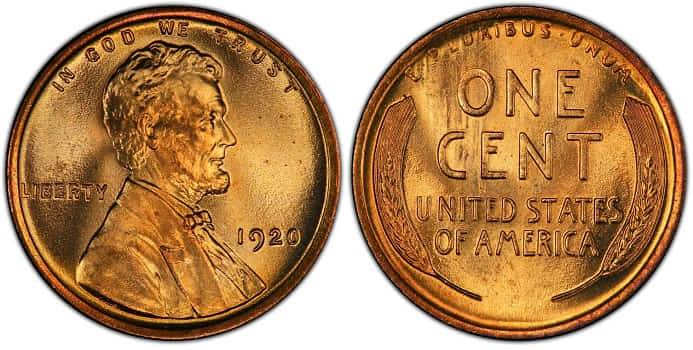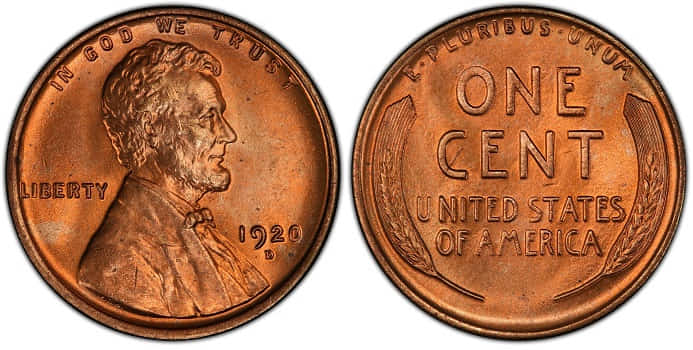Ed. note: This article is periodically updated to reflect the current price of most valuable coins.
In Coleccionistas de Monedas, we fight against the misinformation surrounding the world of coins on the web. For this reason, our articles are written 100% by people (not AI), and we link to all sources and references for coin prices, so you can have real, updated, and reliable information.
Pennies are the lowest value coin in circulation in the United States, and for this reason, they are abundant and recognizable. It may seem that for this reason, they may be of little interest to collectors, however, the opposite is true. These small coins are one of the wheat pennies to look for more important in American numismatics. However, not every penny is suitable for a collector to pay a large sum of money.
Coleccionistasdemonedas.com Estimated Value of 1920 Lincoln Wheat Penny is:
- In average grades can be found between $0.20 and $0.50.
- In high grades (MS67, MS68), Proofs, Uncirculated (MS+), or Mint Condition, it can be worth up to $126,500.
How much is a 1920 wheat penny worth today?
JUMP TO SECTION
1920 Penny Value Chart by Grade, Patina and Mint Mark
| Mint Mark | Patina | MS63 | MS64 | MS65 | MS66 | MS67 |
|---|---|---|---|---|---|---|
| No mint mark | BN | $35-38 | $55-70 | $125 | $- | $- |
| No mint mark | RB | $45-50 | $65-80 | $150-175 | $350 | $- |
| No mint mark | RD | $55-65 | $90-100 | $260-300 | $650-1,200 | $6,500-16,000 |
| D Mint Mark | BN | $135-150 | $250-285 | $450 | $- | $- |
| D Mint Mark | RB | $225-265 | $315-375 | $700-800 | $2,400-2,650 | $- |
| D Mint Mark | RD | $285-325 | $550-750 | $2,000-3,500 | $21,500 | $- |
| S Mint Mark | BN | $200-240 | $475-550 | $800-1,650 | $- | $- |
| S Mint Mark | RB | $325-375 | $700-950 | $2,000-2,750 | $9,500 | $- |
| S Mint Mark | RD | $950-1,000 | $1,650-3,750 | $12,500-50,000 | $- | $- |
Due to their common circulation, they are usually found quite worn out, which is why conservation is one of the most important factors for their higher price.
Being a coin that can be obtained very cheap in general, extraordinary cases do occur like, for example, this 1920-D Wheat Penny MS66 RD auctioned for $25,300 by Heritage Auctions.
Within the 1920 Wheat pennies, patina is a factor of great importance. Also, certain errors can greatly increase their value due to their scarcity and high demand by collectors as we will see below.
What’s a 1920 penny worth?
Since 1909, U.S. pennies have featured the bust of Lincoln on the obverse, a design by Victor David Brenner.
What were pennies made of in 1920?
The weight of these coins remained at 3.11 grams until 1982. The metals that make up a 1920 Wheat Penny are 95% copper and 5% tin and zinc. In contrast, today they weigh as little as 2.5 grams and are made of copper-colored zinc.
How can you tell if you have one?
On the reverse of the one-cent coins minted between 1909 and 1958, we can see two ears of wheat surrounding, as if it were a laurel wreath, the central legend “ONE CENT – UNITED STATES OF AMERICA”. Just above this legend, appears the Latin motto “E PLURIBUS UNUM” (From many, one), common on American coins.
These spikes are the ones that give the wheat penny its name. To know the year of the coin we must look at the obverse. There we can see on the right side of Lincoln’s bust, the date “1920“. Under this number there may or may not be a letter, this is the mint, that is, the factory where it was produced. Above the bust of Lincoln, another motto appears, “IN GOD WE TRUST”, and to the left of it, the word “LIBERTY”.
Types of mint marks
The 1920 Wheat Penny is very abundant, with a mintage of over 400 million coins. There are three mints for their manufacture, a typical factor that distinguishes American coins in price.
To identify the mints on our cents, just look at the letter on the obverse, which has been mentioned above, under the number indicating the year of issue.
Each mint has a different mintage, which is why it is important to know the abundance or scarcity of coins minted in each city.
Table of types of coinage/mint marks
| Mintmark | Variety/Serie | Mint | Where’s the mint mark? | Number of units | Good investment? |
|---|---|---|---|---|---|
| No Mintmark | 1920 Lincoln Penny | Philadelphia Mint | No Mintmark Under Date | 310,165,000 coins | No |
| D | 1920-D Lincoln Penny | Denver Mint | D Mintmark Under Date | 49,280,000 coins | Yes |
| S | 1920-S Lincoln Penny | San Francisco Mint | S Mintmark Under Date | 46,220,000 coins | Yes |
Denver and San Francisco mints are the scarcest and therefore somewhat higher valued.
Three varieties of patinas to identify in the 1920 Cents
In addition to the mint, other differences must be taken into account to determine a greater or lesser value.
The main one is the quality, as in any other coin, as we will see later, but now let’s talk about the patina.
The patina is, simply explained, the tone or color of the coin. In more complex terms is the oxidized metal that coats many ancient bronze and copper coins.
Specifically, the patina is the result of the oxidation of the metal due to the contact with air and other elements that causes some or other colors. An original patina, generated by the years of “life” of the coin, is highly valued by collectors, therefore a coin should never be cleaned without consulting an expert since in most cases its value will be greatly diminished.
Due to their high copper content (95%), 1920 Wheat Penny has three different types of patinas, mostly of which there are three different abbreviations, BN, RB and RD. These are abbreviated by three different abbreviations, BN, RB and RD. Each one is more complex to find than the previous one, which is why the price increases due to the difficulty.
With coins as common as these, priority is given to the most special patinas, so a BN or RB may be undervalued, while an RD makes the coin more expensive because it is so rare in common coins.
BN patina

In some specimens with this patina that have not been circulated very often, greenish or bluish colors can be seen, normal in this metal, which makes it much more striking.
RB patina
It is the abbreviation of Red and Brown, i.e., as the previous patina, it is a brown specimen, but retains the typical reddish tones of a newly minted copper coin.
It is the result of better environmental conservation, or at least with less exposure to humidity and oxygen than the previous one, regardless of whether a BN has hardly been circulated, but has been stored in a humid place.
This makes it somewhat rarer than the previous one and therefore costs a little more money.
RD patina
It is the red patina that copper coins have when they are newly minted, the rarity of this patina is the difficulty for a coin to be preserved with that tone for so many years.
It is the most expensive patina of the three, being the most appreciated by collectors.
To preserve the actual patina of our coins, it is important to keep them in a stable and controlled place. This is why certified capsules are a wonderful option both for this and for knowing the grade as we will see below.
How do I know if my 1920 Wheat Penny is rare?
The higher the grade, the higher the price increases exponentially, since it is a factor of great importance, especially in coins that tend to circulate a lot, as is the case of cents.
To know the state of conservation of the coin we own or want to buy, we need to have an expert eye that we can hardly acquire without time or experience. This is why it is not a bad idea to resort to a TPG (Third Party Grading Service). These are companies dedicated to evaluating and awarding a score to our coins according to their condition. In addition, they certify the authenticity and encapsulate the coin for security purposes, both for its preservation and to facilitate its sale.
Conclusions
We have seen that 1920 is a curious year for Penny collecting. Most of the mintages are quite mediocre, so patinas and high grades will be more valued than in other years.
While most will not be of great value, checking your pockets can make you a lot of money if you find a special 1920 Wheat Penny.
This is a great option to get started in a Lincoln Wheat Penny collection or, in general, U.S. currency since as we said at the beginning, pennies are the most collected U.S. coin in the world.
References and sources
- Heritage Auctions
- NGC Coins
- The Official Red book 2024: A Guide Book of United States Coins.
Numismatic Expert & Writer. BA in History and BS in Computer Science. He’s a member of the American Numismatic Association (ANA) and the Numismatic Literary Guild (NLG) and write in several digital media specialized in collecting, auctions and antiques reviews.
Expertise
He is an active investor and a member of the coin collecting community, specializing in antique United States coins. He uses this expertise to disseminate knowledge and interest in coins among the broad audience of Coin Collectors through both simple and high-level articles.
Features in Other Publications
Experience
Javier has been an active member of the coin collecting community for approximately 15 years. He has gained extensive experience during this time and wishes to share it with his readers.
Education
He completed a Bachelor’s degree in History from UNED and a degree in Computer Science from the University of Cádiz.




